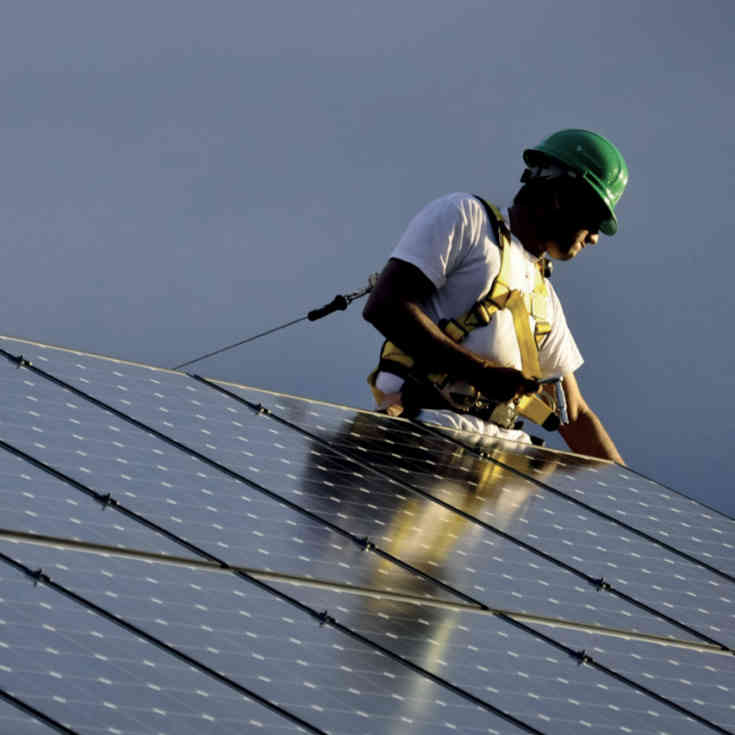Claims
Craig Kelly and the United Australia Party have put out a Youtube video and online ad claiming that Net Zero emissions means zero jobs and zero future.
How does this claim check out?
Verdict

There is absolutely no basis for this claim.
Achieving net zero will actually create jobs.
Renewable energy and jobs
All assessments of future jobs are predictions based (hopefully) on economic modelling. Predictions differ, but here are some competent predictions of future jobs in renewable energy in Australia.
- If Australia followed the Paris Agreement there would be an average of about 34,000 jobs in Australia’s renewable energy sector over the next 15 years, with a peak of 45,000 and a low of 15,000 (UTS Institute for Sustainable Futures, June 2020).
- Moving to 50% renewable energy by 2030 would create 28,000 new jobs, 50% more than would be created by present policies (Ernst & Young, 2016 for the Climate Council).
- It’s the same in the US too, where even 2 years ago there were three times as many jobs in the renewable energy industry as in the fossil fuel industry (Forbes, 2019).
These assessments show that the renewable energy industry could be very profitable for Australia. Most industry analysts agree that there are great opportunities for Australian industry to move into renewable energy production, making Australia a renewable energy exporter.
The UAP claim is totally wrong and not based on the facts.
Renewables vs coal + gas
But will moving to renewables cost jobs in the coal and gas industries? Will the gain be worth the pain?
Loss of jobs in coal & gas
Currently Australia exports about 70-75% of the coal mined here, with 25-30% used locally. It is expected that no new coal-fired power stations will be built in Australia because they are far more expensive than renewable power sources. Existing coal-fired station will likely be phased out in 20 years or less. So regardless of the government policy on net zero, jobs will be lost as the Australian domestic market declines.
More significant for jobs is the coal mined for export. Demand for coal is expected to continue for some years, but it too will decline over time. In addition, jobs will decline because of increasing automation in mining, and if more processing is carried out overseas, as is occurring with the Bravus (formerly Adani) mine. (For these reasons, it is currently expected that this mine will employ only about a fifth of the earlier workforce estimates.)
Thus a reduction of employment in thermal coal mining is inevitable, the only questions are how quickly, and (most importantly) how will these workers be re-employed? Government and industry planning on re-training, location of renewable industry and assistance, are crucial to making this transition as smooth and as painless as possible.
Comparison: renewables vs thermal coal
It is hard to get accurate figures, because most sources have a position to defend, either for or against coal mining. But it seems that presently:
- About a quarter of a million people are employed in all mining in Australia (the numbers obviously fluctuate). This comprises 2% of Australia’s workforce.
- Of these, about 40,000 to 50,000 are employed in the coal industry (again, estimates vary and the figures fluctuate over time).
- But relevant for the comparison with renewable energy production is the employment in thermal coal (coal used in electricity generation). This comprises about 60% of Australia’s coal usage – the remaining 40% is metallurgical coal, used in iron ore making. Thus the best estimate for employment in the thermal coal industry seems to be somewhere between 25,000 and 30,000, which is about 0.2% of the Australian workforce.
Thus it appears that (1) there will be a significant reduction in thermal coal industry jobs in the next few decades, most of this regardless of any net zero commitment, and (2) the number of people employed in the renewable energy industry will probably be slightly more than the number of jobs lost in thermal coal.
The Australia Institute has estimated that there would be a negligible impact on the Australian economy if there was a moratorium on new coal mines, although mining interests disagreed.
The bottom line
Thermal coal is in decline, and adopting an ambitious net zero target will hasten this decline a little. Renewable energy is the way of the future, environmentally and economically.
The UAP advertising isn’t based on facts. It may be based on Clive Palmer’s mining interests. Net zero doesn’t mean zero jobs, but slightly more jobs. But the transition has to be managed well.
Photo: solar panel installation (Climate Council, used with permission).
